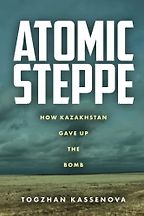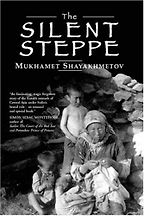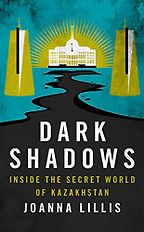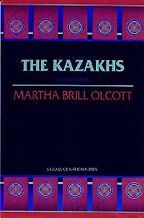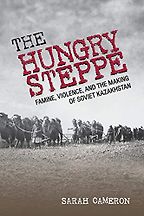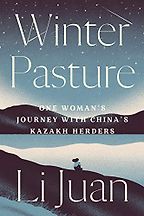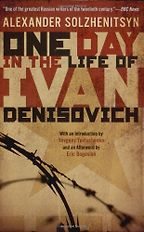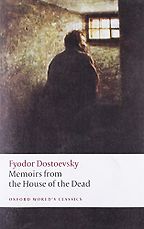Kazakhstan Books
Last updated: May 23, 2025
There's a reasonable range of books about Kazakhstan in English, a country in Central Asia that became independent in 1991, following the fall of the Soviet Union. Buoyed by its oil wealth, independent Kazakhstan was led by President Nursultan Nazarbayev for nearly 30 years, the percentage of votes he won at each election edging closer and closer to 100 until he resigned and ceded the presidency to a close ally in 2019.
Measured by landmass, Kazakhstan is the 9th largest country in the world. Under Stalin, it was the site of a web of concentration camps, as well as being a convenient location for groups to be deported to, such as the Volga Germans, who were sent there en masse after Hitler invaded the Soviet Union in 1941.
In Soviet times, Almaty was the capital of Kazakhstan, and it remains the country's most vibrant city. However, in 1997, the official capital of Kazakhstan was moved more than 1,000 kilometres to a city that is now called Nur-Sultan, after the country's longstanding president.
Below are some books about Kazakhstan to help get a grip on its history and current situation:
“When things started going wrong in Kazakhstan earlier this year, I started dipping into a few books about it and found its history fascinating. The vast, wide-open steppe made it a place of herders for millennia, but during the Soviet era it was also a convenient location for deporting entire populations, locating gulags, and carrying out nuclear testing, which is what Atomic Steppe: How Kazakhstan Gave Up the Bomb focuses on. It’s by Togzhan Kassenova, a Fellow at the Carnegie Endowment for International Peace in the United States, but also a Kazakh. She writes of her ‘immense gratitude for the privilege of telling the story of my land and its people.’ It’s scholarly and yet touching. Also, as many world powers seem to be heading closer to war rather than away from it, it’s perhaps hopeful that in the not-too-distant past a country that had more than 1,000 nuclear weapons when it became independent ended up nuclear-free.” Read more...
Notable Nonfiction of Early 2022
Sophie Roell, Journalist
The Silent Steppe: The Story of a Kazakh Nomad Under Stalin
by Mukhamet Shayakhmetov
This is a firsthand account, matter-of-fact in tone, by a Kazakh herder of his life growing up in 20th century Kazakhstan. Born in 1922, Mukhamet Shayakhmetov's life revolves around his 'aul', the traditional Kazakh family grouping that is both abstract and the collection of yurts that moves around between winter and summer—with herds of camels, horses, cattle and sheep. He is just 7 years old when Stalin's campaign to dispossess the kulaks reaches Altai in 1929, netting first his uncle and then his father. By 9 he is acting as the man in the family, going long distances on horseback on his own to get food for his father in prison. He manages to survive both the Kazakh famine and the Great Patriot War, fighting in the army at Stalingrad. It's a tragic tale, the lack of comprehension of the Kazakh herders at what the Soviet bureaucratic state was up to painful to read. Early in the book, when the political persecution is just getting going, he's at a trial and notes how everyone was astonished by the proceedings: "some even dared to laugh."
Dark Shadows: Inside the Secret World of Kazakhstan
by Joanna Lillis
In Dark Shadows (2018), Almaty-based journalist Joanna Lillis introduces readers to modern Kazakhstan, the Central Asian republic that became independent of the Soviet Union in 1991 and was ruled by one man—Nursultan Nazarbayev—until 2019, when he was replaced by a close ally. "He lived through every Soviet leader bar the first, Lenin, and is the only ruler of an ex-Soviet country who has been in power since before the USSR collapsed," Lillis writes. A big part of the story is the country's enormous oil wealth, and how that has fuelled corruption on a massive scale.
The Kazakhs
by Martha Brill Olcott
The Kazakhs by political scientist Martha Brill Olcott was first published in 1986 and is a good English language account of the history of the Kazakh people, from the mid-15th century to the present.
The Hungry Steppe: Famine, Violence, and the Making of Soviet Kazakhstan
by Sarah Cameron
The Hungry Steppe by University of Maryland historian Sarah Cameron is about the 1930-33 famine in Kazakhstan, caused by the forced collectivization and settlement of herders whose livelihood depended on a nomadic existence tending sheep, cattle and camels. More than 1.5 million people died—a quarter of Kazakhstan's population—and yet many of us know little about it. "In its staggering human toll, the Kazakh famine was certainly one of the most heinous crimes of the Stalinist regime," Cameron writes. By 1933 over 90% of livestock had also perished, ending a way of life that had lasted some four millennia.
Winter Pasture: One Woman's Journey with China's Kazakh Herders
by Li Juan
The Kazakhs were traditionally herders, and it's no surprise that in the Altai Mountains—where China, Kazakhstan, Mongolia and Russia meet—they did not see any need to confine themselves to national boundaries. This book was only translated from Chinese last year, and follows Li Juan, who owns a convenience store with her mother in northwestern China, as she spends the winter with a family of Kazakh herders. It's a really nice depiction of a lifestyle that mixes old traditions and coping mechanisms in icy temperatures with new gadgets.
“It was a critical book – an entirely objective account of a victim in a labour camp. Just one day in an ordinary labour camp. Not exaggerated, not even a particularly nasty day. The most extraordinary part is how is got printed. It ran contrary to everyone in the Communist Party in Russia, but the Novy Mir editor Tvardovsky snuck a copy in to Khrushchev and said, ‘This is awfully good, you ought to publish it’. And he did. It was an extraordinary stroke of luck. And once it was printed, as Galina put it, ‘The Soviet government had let the genie out of the bottle, and however hard they tried later, they couldn’t put it back in’… After One Day in the Life, Solzhenitsyn didn’t publish anything for a long time, but meanwhile he was hoarding the real killer book – The Gulag Archipelago. When he published that, he was arrested and sent to the West in handcuffs. That’s where I met him, in Zurich in 1976.” Read more...
Robert Conquest, Historian
Memoirs from the House of the Dead
by Fyodor Dostoevsky, translated by Jessie Coulson
Memoirs from the House of the Dead by Fyodor Dostoevsky is written as fiction but is based on his time in a Siberian prison camp at Omsk. This is not a book about Kazakhstan, but we’ve included it because, on his release, Dostoevsky lived in exile (which included military service) in the Kazakh city of Semipalatinsk. You can visit one of the houses he lived in, which has been turned into a museum.
